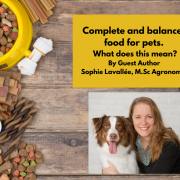Complete and balanced food for pets. What does this mean?
 This article was written by Guest Author, Sophie Lavallée, M.Sc Agronomist
This article was written by Guest Author, Sophie Lavallée, M.Sc Agronomist
Note from the author: This is for all those who are passionate about animal nutrition and the science of life.
I asked myself: How do we define the nutritional adequacy for pets?
Enjoy your read!
“The health and physiological status of pets can only be maintained if all nutritional elements are provided with the minimum requirement on an ongoing basis.” (NRC, 2006).
These nutritional elements, also called nutrients, include energy, proteins and amino acids, fats and fatty acids, macro and micro-minerals and vitamins.
These requirements are expressed either in minimum need or in recommended allocations for each of the nutrients and for each physiological stage of the animal. Thus, a growing puppy post-weaning and an adult dog will have defined and specific needs at their stage of life. The same goes for kittens and cats. In addition, for certain nutrients, there is also a safe maximum limit so as not to cause toxicity problems in dogs and cats. These data, minimum and maximum, are derived from the scientific literature for several decades, are peer-reviewed and include other ongoing research. Cases of impairment or toxicity are documented in several studies including several topics with their health effects related to the respective levels.
Despite this, data remains unknown, leaving some of the minimum nutrient requirements undetermined, in which case the needs are determined on an adequate intake or recommended allocation basis. The precautionary principle is then required to ensure that the body is filled to achieve optimal nutritional balance and an ideal weight.
Therefore, the bioavailability of nutrients must be taken into account, i.e. the degree of assimilation of a nutrient and the use of it by the animal. When a minimum value of a nutrient is it used, the nutrient assimilation in the ingredient must be 100%, otherwise the addition of a suitable factor must be considered. The biological value of ingredients is a similar concept where the degree of conversion of food proteins into body proteins is taken into account. Fresh meat and eggs are examples of products with very high bioavailability, for which amino acids are easily assimilated and used by the body. A good formulator uses nutritional targets to decide on the inclusion of ingredients, taking into account their quality and biological value.
The priority of proper nutrition is based first on a complete and balanced recipe, using quality ingredients approved for animal feed. Then other functional ingredients can be useful and complementary to the proper functioning of the body. For example, natural antioxidants, prebiotics and probiotics, organic acids. These can reduce oxidative stress, nourish the gut microbiome, decrease the population of bad bacteria, improve immunity, etc. …
Approved ingredients for the diet of dogs and cats are listed in the Association of American Feed Control Officials (AAFCO) annual publication. These ingredients for which there has been a regulated process to demonstrate that there is no risk of using them for pet feeding. Products such as insects and cannabidiol (CBD) are not yet approved as they are being evaluated.
In summary:
The priority of proper nutrition is based first on a complete and balanced formulation, taking into account the bioavailability of the nutrients contained in the ingredients. The use of AAFCO-approved ingredients and the conduct of appropriate animal testing.
As an animal feed professional, the principle of precaution should be put forward to ensure the health and well-being of pets.
References:
National Research Council, 2006, Nutrient Requirement of Dogs and Cats. The National Academic Press
About the author:
Sophie holds a master’s degree in animal science/monogastric nutrition from McGill University – Macdonald Campus. She is passionate about innovation in animal nutrition with expertise in research and development of over 20 years, 7 years of which were exclusively devoted to developing several new complete and balanced food recipes and supplement for dogs and cats. Her interest in the field of pet nutrition is first and foremost the scientific aspect of living things and the proper use of resources. Her active participation in the marketing of new products and the improvement of well-known brands allow her to consolidate her knowledge on the subject. Now an independent professional, she provides consulting services to people in the animal nutrition industry as well as start-up companies to help them make their way into the market and to enable them to make the best products that meet recognized nutritional standards.



